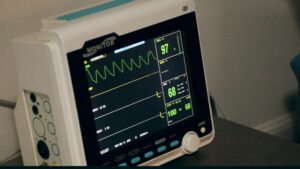There are a lot of different blood pressure monitors on the market, and it can be hard to decide which one is right for you. In this article, we will discuss the different types of blood pressure monitors and help you choose the best one for your needs.
What is a Blood Pressure Monitor?
A blood pressure monitor is a device that measures the pressure in your blood vessel. This can help to diagnose and treat hypertension (high blood pressure). There are different types of monitors, but all work in the same way. You put on a special cuff and it records the pressure inside your cuff as you breathe in and out.
How Does the Monitor Work?
A blood pressure monitor is a small, wearable device that measures the pressure in your blood vessels. It consists of a cuff that fits around your arm and a sensor that monitors blood flow. When you take a reading, the monitor calculates your average blood pressure over time.
There are many different types of monitors, but all work in essentially the same way. The cuff inflates and contracts according to the amount of blood flowing through it, and the sensor detects this movement. The monitor then calculates your average pressure over time.
Different monitors have different features, but all of them rely on this basic principle. Some monitors also have sensors that track other heart health indicators, like heart rate or oxygen levels, but these are not covered in this article.
The most important thing to consider when selecting a blood pressure monitor is your needs. Most people need a monitor that can detect both systolic (the top number) and diastolic (the bottom number) pressures. However, not all monitors measure both numbers at once; some only measure one or the other. If you only care about one number, you should choose a monitor that measures just that parameter. However, if you want to know
The Different Types of Monitors
There are a variety of blood pressure monitors on the market, each with its own advantages and disadvantages. To make the best decision for your needs, it’s important to understand the different types of monitors and their uses.
The traditional monitor uses a sphygmomanometer (a cuff-like device) to measure blood pressure. The most common type of these monitors is the mercury sphygmomanometer, which requires you to slowly release mercury into the cuff over a period of time to determine your average blood pressure. These devices have been largely replaced by digital monitors, which use electronic sensors to measure blood pressure.
Digital monitors are generally more accurate than mercury sphygmomanometers, but they can be less accurate in people with high blood pressure or of African American descent. They also require less calibration than mercury sphygmomanometers, so they’re generally recommended for people who aren’t worried about their environmental impact. However, digital monitors can be difficult to read if your blood pressure is elevated, so they’re not recommended for people with hypertension or a history of hypertension.
There are also hybrid devices that combine features of both digital and mercury sphygmomanometers. These monitors are generally more accurate than either
What to Look for in a Good Blood Pressure Monitor
When it comes to keeping track of your blood pressure, there are a few key things to look for in a good monitor. Here are four key features to keep in mind: accuracy, ease of use, features, and price. Accuracy is essential for ensuring that you are getting an accurate reading of your blood pressure. A good monitor should be able to consistently read your blood pressure reading within a certain range, typically within 5-10 mmHg. Ease of use is also important – a good monitor should be easy to understand and use, without requiring too much special knowledge or training. Features can include things like automatic measurements of your blood pressure over time, sleep tracker functionality, and more. Finally, price is always a consideration – a good monitor will usually cost less than a high-quality generic alternative.
How to Use a Blood Pressure Monitor
Blood pressure monitors are important for keeping blood pressure under control, so take your first readings. Make a diary or journal to keep track of your progress in order to be able to see how well you’re doing and make adjustments.
The Pros and Cons of a Blood Pressure Monitor
Blood pressure is one of the most important measurements you can take, and there are a variety of different monitors to choose from when it comes to checking your blood pressure. Here are the pros and cons of each type of monitor:
Digital Blood Pressure Monitors:
Digital blood pressure monitors are becoming more popular than ever before because they are easy to use, portable, and have many features that allow you to track your progress over time. Some of the benefits of using digital blood pressure monitors include that they are easy to read, have a large display, and can be synced with devices like smartphones and computers. However, some people find that digital blood pressure monitors can be inaccurate, and they may require calibration from time to time.
Aneroid Blood Pressure Monitors:
Aneroid blood pressure monitors use a mercury-based chamber that measures the pressure inside the chamber. This type of monitor is more accurate than digital monitors, but they can be more expensive and have a longer lifespan. Aneroid blood pressure monitors also require manual adjustment in order to maintain accuracy, which can be a hassle if you’re not comfortable doing it.
Conclusion
When it comes to blood pressure monitors, there are a lot of different options out there. Which one is right for you? Well, that depends on a few things: your lifestyle, the type of monitor you want, and your budget. That said, here are four blood pressure monitors that should be at the top of your list if you’re looking for an accurate reading:

Leave a Reply